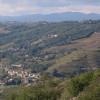
TEN YEARS ON: 2009, STILL VINTAGE OVER TERROIR
APRIL 2019
I recently conducted a tasting for the Solicitors’ Wine Club in London, where NORTHERN RHÔNE 2009 was in the spotlight. There were four wines from the micro-négociant TARDIEU-LAURENT, and four from the mix of own vineyards and négociant activities of PAUL JABOULET AÎNÉ.
2009 was a vintage that presaged a decade of increasing temperatures, and dry, very hot summers in some instances. I link it to 2003, the year of what the French term la canicule – the sweltering heat – when hundreds of people, many of them elderly, died in PARIS, and the RHÔNE encountered ripeness and conditions that had all the old timers scratching their heads.
2003 was regarded at the time as being completely out of the loop. The jammy density of the wines masked terroir influences, and the early problems stemmed from tannins that were inclined to be dry, sometimes parched. However, the wines have held together better than expected, and are still pretty vibrant, even if their still thick texture stands outside the usual norms of wines at 15+ years’ old.
Looking back, 2009 now bears a relationship with 2015, 2017 and 2018. All these summers were very hot, and dry, bar the odd storm here and there, random acts from the heavens. Of these vintages, I expect 2015 to be the most capable of showing terroir as it evolves, with the others stuck for some time in the vintage-influence channel. A comparison can be made with 1999 at CÔTE-RÔTIE, for instance. Until around 2015, most of those wines were still showing solar density and padding rather than the gunflint and spark of their rocky origins.
MICHEL TARDIEU remembers 2009 with mixed emotions: “it’s a medium level vintage for me, one on excess and heat,” he relates. "I made five casks of CORNAS VIEILLES VIGNES, and it was my favourite of the vintage: it was made in the ancient style of the old families, with a more modern oak raising attached by me – a lot of concentration, colour, wild black berry fruit above all, blackberries with graphite, the best of the NORTHERN RHÔNE. HERMITAGE was a bit austere, didn’t have the degree, wasn’t in the style of the CORNAS, was more calm than the CORNAS, too.”
Across the 2009 CROZES-HERMITAGE, SAINT-JOSEPH, CORNAS and HERMITAGE REDS shown, the winner on the night was the 2009 CORNAS TARDIEU-LAURENT VIEILLES VIGNES – no surprise to me. This was 67% PATOU, the sunny southern lieu-dit of DUMIEN-SERRETTE, the SYRAH dating from the 1920s, 33% LES EYGATS, the cooler, higher lieu-dit where STÉPHAN CHABOUD, based in SAINT-PÉRAY, works his 1950-1960s SYRAH.
Alongside it, the profile of the JABOULET DOMAINE DE SAINT-PIERRE was markedly different. For a start, the vines are much younger, dating from 1985-86, when the JABOULET family decided they were missing out, and that there existed potential at CORNAS. They therefore initiated a planting programme on the cheaper land high up at 300-320 metres near the little chapel of SAINT-PIERRE, which stands away from the main hillsides visible from the N86 road linking CORNAS and SAINT-PÉRAY.
The raising for the TARDIEU-LAURENT was 15 months new oak, then 9 months in 1-2 year casks, total 24 months. For the JABOULET, it was 12 months in 20% new, 80% 1-2-3 year casks. The 1,520 bottles of TARDIEU-L stood alongside the 13,000 bottles of the JABOULET.
Unfortunately, there were below par bottles of the JABOULET ST PIERRE – some cooked, and lacking freshness. The best delivered a sturdy attack, thick juice – very 2009 - with punchy tannins, but the finish started to dry as it aired, and I had the feeling of a slightly fragile spine running through it.
The TARDIEU-LAURENT CORNAS was rich on both bouquet and palate, came with good ground force, real persistence. It gathered a good accumulation of juice on the close, was a sumptuous, sunny and full wine, real PATOU in style – so here vintage and terroir combined well. At the time, I wrote of 2009 at CORNAS: “2009 represents modern CORNAS above all, wines that are frequently fleshy, shapely and full of juice. In this respect, they resemble 1999, but winemaking has moved on since 1999, with the result that 2009 tannins are relatively riper than those of the previous decade.” The T-L CORNAS delivered that message very truly 10 years on, and will run for at least another 20 years.
The other wines of the evening were still generally on vintage over terroir. They were
CROZES-HERMITAGE PJA DOMAINE DE THALABERT [a good ensemble, thick fruit, quiet complexity], a wine ahead of the CROZES-HERMITAGE T-L VIEILLES VIGNES [oak-caramel, polished, souped up, terroir under siege from oak]. Both were 14° on the label – up to 14.5° in reality – indicative of the heat of the year, and an unaccustomed level ten years ago.
SAINT-JOSEPH PJA LE GRAND POMPÉE [some fine grain, granite influence, but dull, advancing early, behind the SAINT-JOSEPH T-L VIEILLES VIGNES [refined, floral, elegant, oak better integrated than on their 2009 CROZES, a good example of 2009]
HERMITAGE PJA LA PETITE CHAPELLE [chunky wine, thick constituents, not much terroir, SYRAH from BORDEAUX, a bit common next to the HERMITAGE T-L [the elegant ease of the central zone, more personality, more detail and more genuine HERMITAGE than the PJA].
THE CONCLUSIONS
TARDIEU-LAURENT 3 PAUL JABOULET AÎNÉ 1
VINTAGE 2009 still in the driving seat, but local influence starting to emerge in well made wines. Any reader seeking a counterpoint year – when there is little to no weather masking – should head for 2012, 2014 or 2016, and, in older vintages, 2006.

